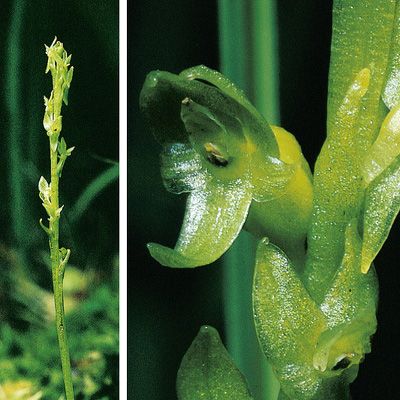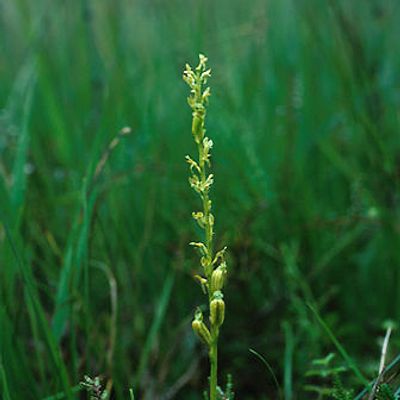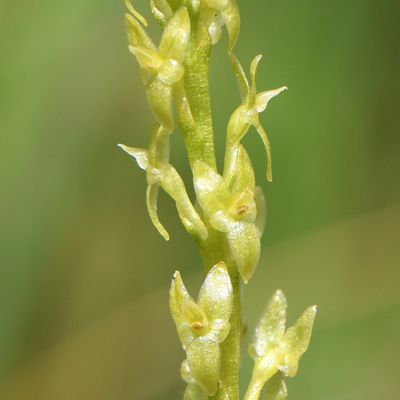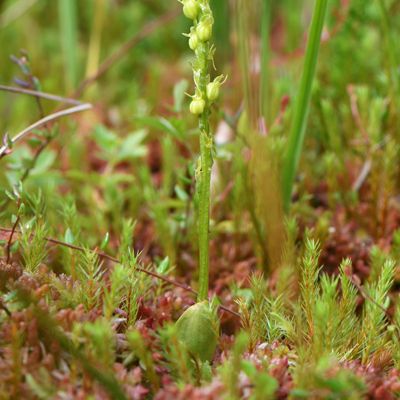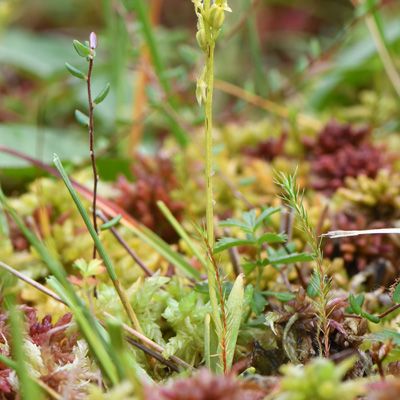Hammarbya paludosa (L.) Kuntze
1022080
Species
ISFS : 193900
Checklist : 1022080
ISFS : 193900
Checklist : 1022080
Contains :
Synthesis
Species description (© Flora Helvetica 2018)
3-12 cm hoch, am Grund mit 2-3 ovalen, aufrechten Blättern, das oberste (grösste) höchstens 3 cm lang. Blütenstand sehr schlank, 1,5-5 cm lang, allseitswendig. Blütenstellung wie bei Malaxis. Blüten gelblich bis grün. Perigonblätter abstehend, lanzettlich, die äusseren stumpf, 2,5-3 mm lang, die inneren zugespitzt, 1,5-2 mm lang. Lippe lanzettlich, ungeteilt, etwa so lang wie die inneren Perigonblätter. Kein Sporn.Flowering period (© Flora Helvetica 2018)
7-8Habitat and distribution inside Switzerland (© Flora Helvetica 2018)
Hochmoore / montan / ZG, SZ, SGWorld distribution (© Flora Helvetica 2018)
Eurosibirisch-nordamerikanischEcological indicator (© Landolt & al. 2010)
4+w12-43+2.g.2n=28Status
IUCN status
Critically endangeredNational Priority
2 - high national priorityInternational responsibility
1 - weakConservation
Threats
Entwässerung, Meliorationen
Eutrophierung
Tritt (die Art und ihr Lebensraum reagieren sehr empfindlich auf Trittbelastung, die Art ist sehr schwer zu sehen), Sammeln
Bautätigkeit (touristische Anlagen, Strassen, Leitungen)
Beweidung
Kleines Areal, isolierte Populationen
Distribution map
Habitat and distribution inside Switzerland
ZG, SZ, SGWorld distribution
Eurosibirisch-nordamerikanischEcology
Life form
Geophyte
Habitats
Milieux Phytosuisse (© Prunier et al. 2017)
Habitats © Delarze & al. 2015
 | 2.2.4 - Übergangsmoor (Caricion lasiocarpae) |
bold
Dominant species, influencing the appearance of the habitat
 Character species
Character species
 Less strictly linked to a specific habitat
Less strictly linked to a specific habitat
Ecological indicator values by © Landolt & al. (2010)
| Soil factors | Climatic factors | Salinity tolerance | |||
|---|---|---|---|---|---|
| Humidity Value H | -- | Light Value L | -- | Salinity Index | -- |
| Reaction Value R | -- | Temperature factor T | -- | ||
| Nutriments value N | -- | Continentality K | -- | ||
- Ecological values legend
Humidity Value H 1 very dry 1+ dry 2 moderatly dry 2+ moist 3 medium wet 3+ wet 4 very wet 4+ soggy 5 submerged or underwater f plants living in running water u mostly submerged plants v partly submerged, partly floating plants w humidity moderately variable (± scale of 1-2) w+ highly variable humidity (scale exceeding ± 2) Reaction Value R 1 Very acid (pH 2.5-5.5) 2 acid (pH 3.5-6.5) 3 lightly acid to neutral (pH 4.5-7.5) 4 neutral to basic (pH 5.5-8.5) 5 basic (pH 6-5 -> 8.5 Nutriments value N 1 very low in nutrients 2 low in nutriments 3 medium-poor to medium-rich in nutrients 4 rich in nutriments 5 very rich in nutriments Salinity tolerance 1 halotolerant 3 halophyle Light Value L 1 very shady 2 shady 3 lighted areas 4 luminous 5 highly luminous Temperature factor T 1 alpine to nival stages (from the treeline to the snowline) 1+ suprasubalpine and upper subalpine levels (pine and larch forests) 2 subalpine level (coniferous forests without beeches up to the upper limit of spruces) 2+ lower subalpine and upper mountain stages 3 mountain level (beech and silver fir forests, in the central Alps Scots pine forests) 3+ lower mountain and upper hill levels 4 hill level (mixed deciduous oak forests) 4+ hot places, hill level 5 very hot places, hill level (only in the hottest places, typical of southern Europe) Continentality K 1 Atlantic (high air humidity, very low temperature variations, mild winters) 2 Sub-Atlantic (high air humidity, low temperature variations, relatively mild winters) 3 sub-Atlantic to subcontinental (average air humidity, moderately variable temperature, slightly low winter temperatures) 4 subcontinental (low air humidity, large temperature variations, rather cold winters) 5 continental (very low air humidity, very large temperature variations, cold winters)
Water dependency
| Rivers | 0 - No link |
| Calm water | 1 - Secondary habitat |
| Ground water | 0 - No link |
Nomenclature
Accepted Name (Checklist 2017)
Hammarbya paludosa (L.) Kuntze
Vernacular name
Deutscher Name :
Sumpf-Weichwurz, Sumpf-WeichkrautNom français :
Malaxis des maraisNome italiano :
HammarbiaMatch with other reference books
| Relation | Nom | Book | No |
|---|---|---|---|
| = | Hammarbya paludosa (L.) Kuntze | Checklist 2017 | 193900 |
| = | Hammarbya paludosa (L.) Kuntze | Flora Helvetica 2001 | 2999 |
| = | Hammarbya paludosa (L.) Kuntze | Flora Helvetica 2012 | 2585 |
| = | Hammarbya paludosa (L.) Kuntze | Flora Helvetica 2018 | 2585 |
| = | Hammarbya paludosa (L.) Kuntze | Index synonymique 1996 | 193900 |
| = | Hammarbya paludosa (L.) Kuntze | SISF/ISFS 2 | 193900 |
| = | Hammarbya paludosa (L.) Kuntze | Welten & Sutter 1982 | 2572 |
= The taxon corresponds to the accepted taxon (Checklist 2017)
< The taxon is included in the accepted taxon (Checklist 2017)
> The taxon includes (among others) also the accepted taxon (Checklist 2017)
< The taxon is included in the accepted taxon (Checklist 2017)
> The taxon includes (among others) also the accepted taxon (Checklist 2017)
Status
Native status
-IUCN list of endangered species (© Walter & Gillett 1997) : No
Status on national Red List 2016
IUCN status:
Critically endangered

Additional information
IUCN criteria: A3c; D
Status on regional Red List 2019
| Biogregraphic regions | Status | IUCN criteria |
|---|---|---|
| Jura (JU) | -- | |
| Mittelland (MP) | CR | A3c; D |
| Alpennordflanke (NA) | CR | A3c; D |
| Alpensüdflanke (SA) | -- | |
| Östliche Zentralalpen (EA) | -- | |
| Westliche Zentralalpen (WA) | -- |
- Legend
EX Extinct RE Regionally Extinct CR(PE) Critically Endangered, Probably Extinct CR Critically Endangered EN Endangered VU Vulnerable NT Near Threatened LC Least Concern DD Data Deficient NE Not Evaluated NA Not Applicable
National Priority Species List Status
| National Priority | 2 - high national priority |
| Need to take action | 2 - |
| International responsibility | 1 - weak |
| Need to monitor populations | 2 - |
Protection status
| International (Bern Convention) | No | |
| ZG | total protection | (01.10.2013) |
| Switzerland | total protection | |
| ZH | total protection | (03.12.1964) |
- Disclaimer
InfoFlora compiles information on protected species as accurately as possible, taking it from the respective cantonal laws. In some cases, however, it was not possible to use the plant names as listed in the original text, but an interpretation of their taxonomy or nomenclature was necessary. The exact meaning of the categories „completely protected“ and „partially protected“ differs among the cantons.
InfoFlora cannot guarantee that the information on the protection status is correct and complete. In case of doubts, we recommend to look up the texts of the respective cantonal law.
Status by sector of activity
| Agriculture-related environmental objectives : | more informations | |
| Forest management environmental objectives : | more informations |
Conservation
Threats and measures
Entwässerung, Meliorationen
Moorflächen mit Fundorten unbedingt als Ganzes und in intaktem Zustand erhalten
verhindern einer schleichenden Entwässerung
Eutrophierung
Grosse Pufferzonen ohne Düngung schaffen
Bewirtschaftungsverträge in den Randzonen, keine Bewirtschaftung in den Kernzonen
Tritt (die Art und ihr Lebensraum reagieren sehr empfindlich auf Trittbelastung, die Art ist sehr schwer zu sehen), Sammeln
Striktes Betretverbot für alle Fundgebiete (auch für Pflanzenliebhaber)
Hinweistafeln zum Naturschutzgebiet
Bautätigkeit (touristische Anlagen, Strassen, Leitungen)
Priorität für die noch existierenden Lebensräume
Beweidung
Keine Beweidung
einzäunen falls Moorflächen noch beweidet werden (dafür zukünftig entbuschen sofern notwendig)
Kleines Areal, isolierte Populationen
Schutz aller Fundorte gewährleisten (bestehende Naturschuzgebiete)
Bestandeskontrollen ca. alle fünf Jahre (nur durch Personen, welche die genaue Lokalität der Pflanzen kennen)
Ex situ-Vermehrung mit Brutknöllchen versuchen (Erhaltungskultur)
Dauerflächen-Beobachtung an einem Fundort
populationsbiologische Untersuchung initiieren
Erfolgskontrolle der Massnahmen gewährleisten
